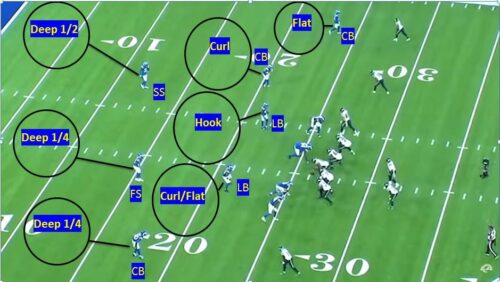By: Chad Wilson
All Eyes DB Camp
IG: @alleyesdbcamp
In the ever-evolving landscape of football strategy, defensive specialists continually strive to develop schemes that can effectively counter the dynamic offenses of the modern game. One defensive strategy that has undergone significant evolution over the years is quarters coverage. Originally conceived as a variation of zone defense, quarters coverage has transformed into a sophisticated and versatile defensive masterclass. In this article, we will delve into the evolution of quarters coverage, examining its origins, key principles, and how innovative coaches have adapted and refined it to meet the challenges of the contemporary NFL.
Origins of Quarters Coverage
Quarters coverage, also known as Cover 4, has its roots in traditional zone defenses. The fundamental concept involves dividing the field into four deep zones, with each defensive back responsible for a quarter of the field. The primary objective is to prevent deep passes and eliminate explosive plays by providing tight coverage on receivers.
The basic structure of quarters coverage remains consistent: two cornerbacks and two safeties each responsible for deep quarters of the field. However, the evolution lies in the nuanced adjustments made by coaches to enhance its effectiveness against the diverse offensive schemes prevalent in today’s game.
Key Principles of Quarters Coverage
Deep Zone Responsibility
Each defensive back is assigned a deep quarter of the field, typically 15-20 yards from the line of scrimmage. Safeties are crucial in quarters coverage, as they must read the quarterback’s eyes, anticipate deep throws, and provide over-the-top support to cornerbacks.

Pattern Matching
Traditional quarters coverage involved defenders dropping to their assigned zones and reacting to the quarterback’s actions. The evolution of quarters coverage incorporates pattern matching, where defenders adjust their coverage based on the routes of the receivers. This adaptive approach allows defenders to maintain coverage even as receivers change their routes.

Run Support
While quarters coverage is primarily designed to defend against the pass, it must also be effective in run support.
Safeties and cornerbacks in quarters coverage are expected to read the run quickly and provide support in tackling ball carriers near the line of scrimmage.
Flexibility and Adjustments
The best defensive schemes are those that can adapt to various offensive formations and play designs. Quarters coverage has evolved to incorporate flexibility and adjustments based on offensive pre-snap movements, formations, and personnel.
Evolution in Modern NFL
Hybrid Safeties
One of the key adaptations in quarters coverage is the emergence of versatile safeties capable of playing both deep coverage and creeping into the box for run support. Coaches seek safeties with a diverse skill set, blending coverage instincts with the physicality to contribute in stopping the run.
Match Coverage Concepts
The evolution of quarters coverage includes the implementation of match coverage concepts. Defenders not only cover a designated zone but also react to the routes of the receivers within their area. This adaptation requires intelligent and communicative defensive backs capable of making split-second decisions based on the movements of the offensive players.
Pre-Snap Disguise
To disrupt the rhythm of opposing quarterbacks, defensive coordinators often incorporate pre-snap disguise into quarters coverage. Safeties may rotate or shift their alignment just before the snap to confuse quarterbacks about the intended coverage, making it challenging for them to read the defense.
Stress on Communication
The success of quarters coverage hinges on effective communication among defensive backs. As the game has sped up, the ability to communicate adjustments and coverages in real-time has become paramount. Modern quarters coverage emphasizes the importance of a well-coordinated secondary capable of quickly adjusting to offensive movements.
The evolution of quarters coverage represents the ongoing chess match between offensive innovation and defensive adaptation in the NFL. From its roots as a basic zone defense, quarters coverage has grown into a sophisticated and flexible strategy that demands a high level of skill, communication, and football IQ from defensive backs. As offensive schemes become more intricate, the evolution of quarters coverage will likely continue, with defensive specialists refining and expanding this strategy to meet the ever-changing challenges posed by the dynamic offenses of the modern game. In the hands of adept coaches and talented defensive backs, quarters coverage remains a powerful weapon in the defensive arsenal, capable of disrupting even the most potent offensive attacks, in particular those that make their living off of the vertical passing game.
I more in-depth on explaining quarters coverage and many other coverages in the All Eyes DB Camp Member’s Area including a grease board session diagraming responsibilities vs. certain routes. Click here for the member’s area.
Chad Wilson is the owner of All Eyes DB Camp and author of "101 DB Tips". He played college football at the University of Miami and briefly in the NFL for the Seattle Seahawks. Over his 15 year high school football coaching career, he tutored over a dozen Division I defensive backs and as a trainer has worked with NFL All Pros, first round draft picks, college football All Americans and Top 10 ranked high school football prospects.






